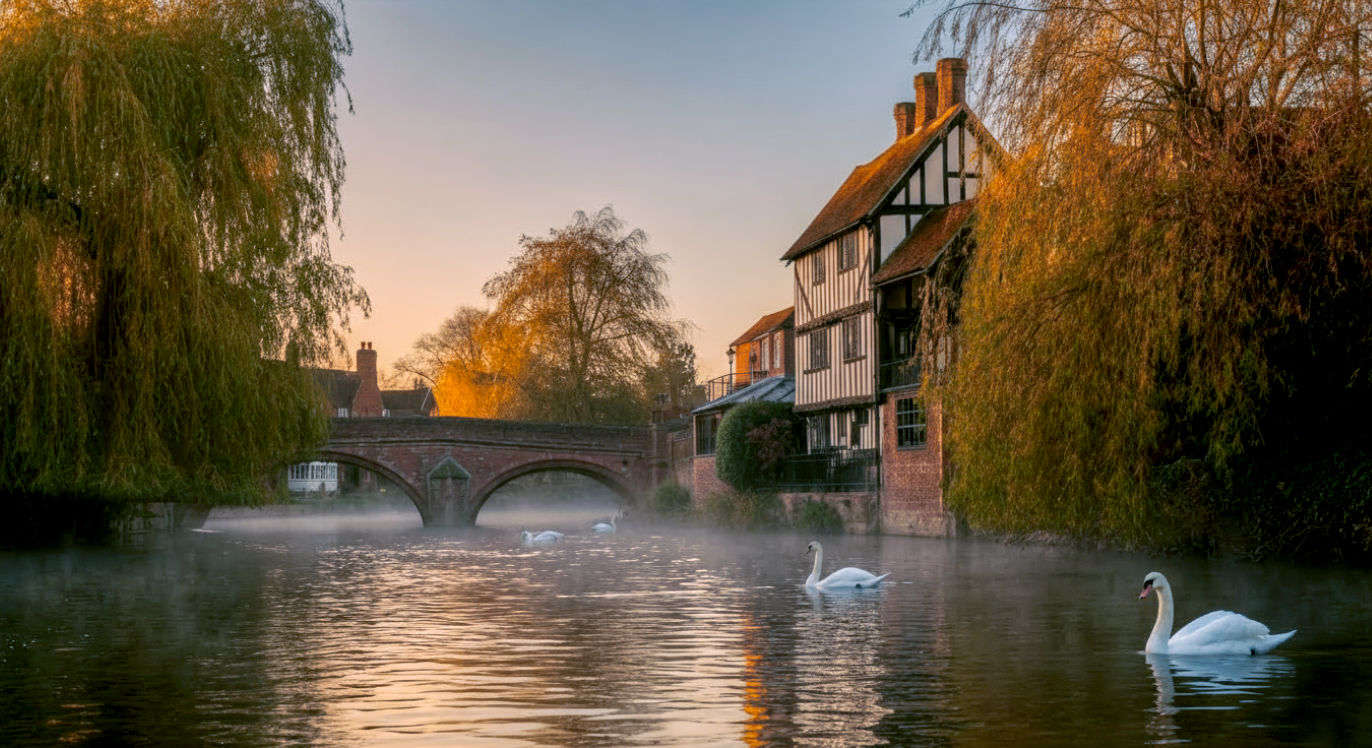Stratford-upon-Avon: Walking in the Footsteps of Shakespeare
Discover everything you need to know about Stratford-upon-Avon. Explore Shakespeare’s homes, see a world-class play, and find the best local spots.

This post may contain affiliate links. If you make a purchase through these links, we may earn a commission at no additional cost to you.
Stratford-upon-Avon. The name itself sounds like a line from a play, doesn’t it? It conjures images of timber-framed houses, graceful swans on a gentle river, and, of course, the face of a man with a quill pen in his hand. For centuries, this pretty market town in Warwickshire has been completely and utterly bound to one person: William Shakespeare.
But to think of Stratford as just a museum piece is to miss the point. This is a living, breathing town, a place where the past isn’t just remembered; it’s practically a chatty neighbour you bump into on the way to the shops. Walking through its streets is like stepping through a time portal. One minute you’re dodging tourists taking selfies, the next you’re standing on the very flagstones where the world’s greatest writer learned to walk, played, dreamed, and eventually, was laid to rest.
This isn’t just a guide to the old buildings. It’s an invitation to walk in Shakespeare’s footsteps, to see the world through his eyes, and to understand how a boy from a middle-class family in a quiet English town grew up to change language and literature forever. So, grab a comfy pair of shoes. We’re going on a journey back in time.
So, Who Was This Shakespeare Chap, Anyway?
Before we dive into the sights, let’s get our facts straight about the man himself. We all know the name, but who was William Shakespeare?
He wasn’t a king or a famous general. He was born in 1564 to John Shakespeare, a glove-maker and wool dealer who was a bit of a big deal in town, even becoming the mayor. His mum, Mary Arden, came from a well-to-do farming family. So, young William had a comfortable start in life. He likely went to the local grammar school, where he’d have had Latin and classical stories drilled into him—stuff you see popping up in his plays all the time.
At 18, he did something a bit scandalous for the time: he married an older woman, Anne Hathaway, who was already pregnant. They had three children: Susanna, and then twins, Hamnet and Judith. Sadly, Hamnet died when he was just 11, a heartbreak that scholars believe haunted Shakespeare for the rest of his life.
Then come the “lost years.” We don’t really know what he was up to in his twenties, but he pops up again in London in the early 1590s, making a name for himself as an actor and a playwright. And what a name he made. He wrote around 38 plays—comedies, tragedies, and histories that have been performed, translated, and studied across the globe—plus over 150 sonnets.
He became a shareholder in his own theatre company, The Lord Chamberlain’s Men (later The King’s Men), and made a tidy fortune. But unlike many who found fame in the big city, he never forgot his roots. He invested his money back in Stratford, buying the second-biggest house in town. When he retired from the London stage, he came home. He died in Stratford in 1616 at the age of 52 and is buried right in the heart of the town he always called home.
The Shakespeare Trail: A Journey Through His Life
The best thing about Stratford is that you can physically follow Shakespeare’s life story from cradle to grave. The Shakespeare Birthplace Trust, a brilliant charity, looks after the five key houses connected to him and his family. Getting a single ticket for all of them is the easiest and most cost-effective way to see everything.
It All Begins Here: Shakespeare’s Birthplace
Our journey starts on Henley Street, at a handsome, timber-framed house that’s seen more than its fair share of history. This is it. The place where William Shakespeare was born, where he grew up with his seven siblings, and where he spent the first five years of his married life with Anne.
Stepping inside is a proper jolt to the senses. The ceilings are low, the floors creak, and the air smells of woodsmoke and history. The house is decorated as it would have been in the 1570s. Downstairs was the family home, but it was also a place of business. You can see his father’s glove-making workshop, complete with smelly hides and the tools of the trade. It’s a powerful reminder that the Shakespeare family were working people, not lofty aristocrats.
Upstairs, you find the bedrooms. The main event is the room where the Bard himself is thought to have been born. The walls are simple, the bed is modest, but the atmosphere is electric. For centuries, visitors—including Charles Dickens, John Keats, and Thomas Hardy—have scratched their names onto the windowpane, a tradition that’s thankfully no longer allowed!
Out in the garden, you’ll often find actors performing snippets of his most famous works. Hearing those immortal lines spoken aloud, right where they were first imagined, is a truly special moment.
A Love Story in the Countryside: Anne Hathaway’s Cottage
A lovely walk or a short bus ride from the town centre takes you to the village of Shottery and one of the most famous thatched cottages in England. This was the family home of Anne Hathaway, Shakespeare’s wife.
Before you even step inside, the cottage is a picture-perfect dream. It’s surrounded by a stunning cottage garden, overflowing with traditional flowers, herbs, and an orchard. It’s incredibly romantic, and it’s easy to imagine a young William strolling through these gardens to court his bride-to-be.
The cottage is much larger than it looks. It was a substantial farmhouse, home to the Hathaway family for thirteen generations. Inside, you can see original furniture, including the “Hathaway Bed” and the “Courting Settle,” a wooden bench by the fireplace where the young couple supposedly sat. The guides here are fantastic, full of stories about Tudor family life, courtship rituals, and the history of the house. It gives you a real insight into the woman who married the world’s most famous writer.
A Glimpse of Tudor Farm Life: Mary Arden’s Farm
A few miles outside of Stratford is Mary Arden’s Farm, the childhood home of Shakespeare’s mother. This isn’t a stuffy museum; it’s a living, working Tudor farm. If you have kids, this is an absolute must-do.
Here, you can experience the sights, sounds, and smells of the countryside that Shakespeare would have known so well. His plays are full of references to nature, animals, and rural life, and this place shows you exactly where that inspiration came from.
You can see rare breeds of animals, watch falconry displays, and see farmhands in period costume going about their daily chores using traditional Tudor methods. They’ll show you everything from milking cows to cooking over an open fire. It’s a wonderfully immersive experience that connects you directly to the earthier, more rustic side of Shakespeare’s world.
The Successful Gentleman: Hall’s Croft and New Place
Back in the town centre, we find two properties that tell the story of Shakespeare’s success.
Hall’s Croft was the elegant home of Shakespeare’s eldest daughter, Susanna, and her husband, Dr. John Hall, a respected and wealthy physician. This Jacobean house is much grander than the Birthplace. It shows how the Shakespeare family had moved up in the world. Inside, you can see Dr. Hall’s consulting room, filled with his medical books, potions, and instruments, which look quite terrifying by modern standards. The beautiful walled garden is a peaceful oasis, planted with the kinds of herbs Dr. Hall would have used in his remedies.
Just a short walk away is Shakespeare’s New Place. This is a site of great importance, but there’s a twist: the house is no longer there. This was the grand family home Shakespeare bought in 1597 when he was making his fortune in London. It was the largest private house in the borough, a clear statement that he’d made it.
Sadly, a later owner, the Reverend Francis Gastrell, got so fed up with tourists knocking on his door that he demolished the house in 1759—an act of cultural vandalism that the town has never quite forgiven him for. But where the house once stood, the Trust has created a breathtakingly beautiful garden. The space is filled with stunning sculptures inspired by Shakespeare’s plays, and the layout cleverly outlines the footprint of the original home. It’s a place of quiet reflection, celebrating the legacy of the man who worked so hard to be able to call this spot home.
The Final Curtain: Holy Trinity Church and Shakespeare’s Grave
Our trail ends at the magnificent Holy Trinity Church, peacefully situated on the banks of the River Avon. This is arguably the most important Shakespearean site of all. He was baptised here in 1564 and buried here in 1616.
You can see the very font where he was christened. But the real destination for every pilgrim is his grave, located in the chancel at the front of the church. He lies alongside his wife Anne, his daughter Susanna, and her husband, Dr. John Hall.
His gravestone doesn’t bear his name. Instead, it has a four-line verse, believed to have been written by Shakespeare himself, placing a curse on anyone who dares to move his bones. It reads:
Good friend for Jesus sake forbeare, To digg the dust encloased heare. Bleste be ye man yt spares thes stones, And curst be he yt moves my bones.
It seems to have worked. His remains have been left undisturbed for over 400 years. Standing there, in the quiet of the church, is a profoundly moving experience. It’s the final, peaceful end to an extraordinary life story that began just a few streets away.
All the World’s a Stage: The Royal Shakespeare Company
You can’t talk about Stratford without talking about the Royal Shakespeare Company (RSC). The town isn’t just about Shakespeare’s past; it’s about his living, breathing legacy. And the RSC is the beating heart of that legacy.
From Humble Beginnings to a Global Stage
The tradition of performing Shakespeare’s plays in his hometown dates back to the 18th century. The first permanent theatre was built in the 1870s, but it tragically burned down in 1926. The magnificent building you see today, the Royal Shakespeare Theatre (RST), opened in 1932.
The RSC itself was founded in 1961 by the visionary director Peter Hall. His mission was to create a world-class ensemble of actors dedicated to performing Shakespeare for a modern audience. Over the decades, some of the greatest actors in British history have trodden these boards: Laurence Olivier, Judi Dench, Ian McKellen, David Tennant—the list is endless.
Today, the RSC complex includes three fantastic theatres:
- The Royal Shakespeare Theatre: A 1,000-seat main stage with a “thrust” design, meaning the stage juts out into the audience. No matter where you sit, you’re never far from the action, creating a wonderfully intimate feel for such a large space.
- The Swan Theatre: A smaller, more atmospheric theatre that often stages plays by Shakespeare’s contemporaries, giving you a brilliant taste of the other incredible playwrights from that era.
- The Other Place: A studio theatre and development hub where new work is created and tested.
Seeing a Play: What to Expect at the RSC
Seeing an RSC production is an experience you’ll never forget. This isn’t dusty, boring Shakespeare. The productions are dynamic, inventive, and often challenge your preconceptions of the plays. You might see Macbeth set in a dystopian future or A Midsummer Night’s Dream with a modern, festival vibe.
Don’t be intimidated if you think you don’t “get” Shakespeare. The actors are masters of the language, making the meaning crystal clear through their performance. It’s a brilliant way to experience these stories as they were meant to be seen: live on stage.
Even if you don’t have time for a full play, you can take a theatre tour, go up the tower for panoramic views of Stratford, or just enjoy a drink in the riverside café.
Beyond the Bard: What Else Is There to Do in Stratford?
While Shakespeare is the star of the show, there’s plenty more to enjoy in Stratford.
Messing About on the River Avon
The River Avon winds gracefully through the town, and spending some time on or near it is a must. You can hire a rowing boat, punt, or motorboat and see the town from a different perspective. Or, if you prefer to let someone else do the work, there are regular river cruises with commentary. The riverside walk from Holy Trinity Church past the RST is beautiful, perfect for a gentle stroll with an ice cream.
Quirky Attractions and Family Fun
- Stratford Butterfly Farm: Step into a tropical paradise filled with hundreds of free-flying, colourful butterflies. It’s a magical experience for all ages.
- The MAD Museum: The UK’s only museum dedicated to Mechanical Art and Design. It’s a wonderfully bonkers and brilliant place filled with whirring, clanking, and interactive kinetic sculptures. Think Heath Robinson meets a mad inventor’s workshop.
- Tudor World: A small, atmospheric museum set in a 16th-century building that explores other aspects of Tudor life, from plagues and punishments to food and games.
A Pint and a Pie: Historic Pubs and Eateries
Stratford is packed with historic pubs. The Garrick Inn, on the corner of Henley Street, claims to be the oldest in town, dating back to the 1400s. It’s a classic timbered pub with low beams and a great atmosphere. Another favourite is The Black Swan, affectionately known as “The Dirty Duck” by actors from the RSC. It’s the unofficial pub for the theatre crowd, and its walls are covered with signed photos of famous actors who have drunk there.
For food, you’re spoilt for choice, from traditional tea rooms serving scones and clotted cream to high-end restaurants and familiar chains.
Your Stratford Adventure: A Practical Guide
How to Get to Stratford-upon-Avon
- By Train: Stratford-upon-Avon station has regular direct services from London Marylebone (around 2 hours) and Birmingham Snow Hill (around 50 minutes). The station is a pleasant 10-15 minute walk from the town centre.
- By Car: The town is close to the M40 motorway. However, be warned that parking in the town centre can be tricky and expensive, especially during peak season. The Park and Ride service is an excellent, stress-free option.
- By Coach: National Express runs services from major cities like London, which can be a very affordable way to travel.
Getting Around Town
Stratford is wonderfully compact. The best way to explore is on foot. Almost all the main Shakespearean properties, the RSC, and the shops are within a 20-minute walk of each other. For Anne Hathaway’s Cottage and Mary Arden’s Farm, there’s a regular hop-on, hop-off tour bus that connects all the key sites.
Top Tips for Tickets and Tours
- Book in advance! This is especially true for RSC plays, which can sell out weeks or even months ahead for popular shows. Shakespeare Birthplace Trust tickets can also be bought online to save time queuing.
- Consider a Town Heritage Trail guided walk. These are led by brilliant local guides who bring the town’s history to life with fascinating stories and anecdotes you won’t find in the guidebooks.
- Check for joint tickets. The Shakespeare Birthplace Trust ticket covers the five main houses and is valid for a year, so you can come back as many times as you like.
When’s the Best Time to Visit?
Stratford is a year-round destination.
- Spring and Summer: The gardens are in full bloom, and the town is buzzing. It’s the most popular time, so expect crowds. Shakespeare’s birthday is celebrated on the weekend closest to 23rd April with a huge parade and festivities.
- Autumn: The crowds thin out, and the autumn colours along the river are beautiful. A great time for a cosy pub lunch after a brisk walk.
- Winter: The town is quieter and can feel very atmospheric. The Victorian Christmas Market is a huge draw, and seeing a festive show at the RSC is a magical experience.
A Town Steeped in Story
Stratford-upon-Avon is so much more than a tourist trap. It’s a town that understands its unique place in the world. It’s the keeper of a story—the story of a local boy who went on to conquer the world with his words.
To walk its streets is to feel a connection, however faint, to that incredible story. You see the school he probably attended, the church where he prayed, the pub where he might have drunk, the house where he raised his family, and the theatre where his words still echo every single night. It’s a town that proves that from the most ordinary of places, the most extraordinary things can grow.
Further Reading
To plan your trip and dive deeper into the world of Shakespeare, these official resources are invaluable:
- Shakespeare Birthplace Trust: The official site for booking tickets to the five Shakespeare family homes and for information about his life and times. (https://www.shakespeare.org.uk/)
- Royal Shakespeare Company (RSC): Find out what’s on, book tickets for plays and tours, and explore their huge online archive of past productions. (https://www.rsc.org.uk/)
- Visit Stratford-upon-Avon: The official tourism website with up-to-date information on accommodation, restaurants, and other local attractions. (https://www.visitstratforduponavon.co.uk/)






